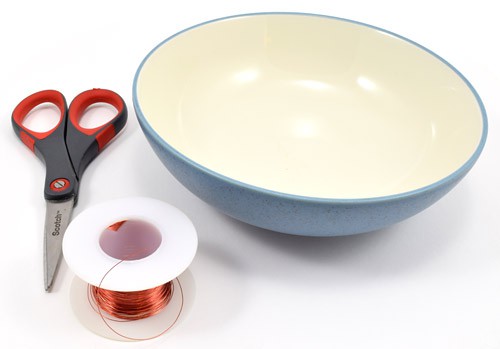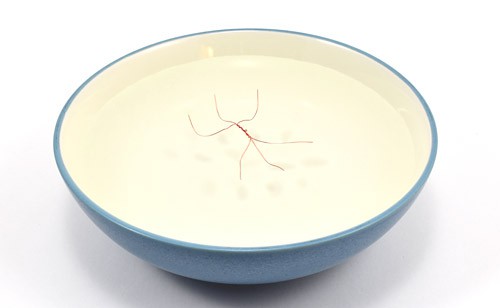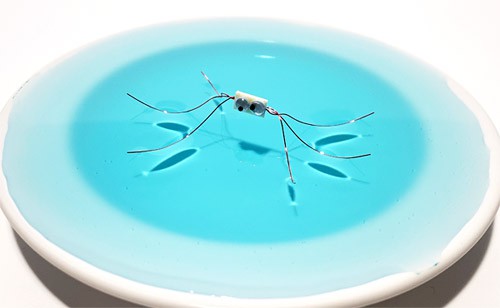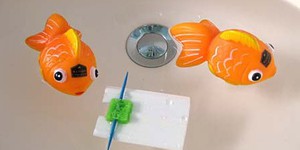Summary
Introduction
Have you ever seen a water strider (also called water bugs, pond skaters, water skippers etc.)? They are bugs that effortlessly hop around on the surface of ponds, lakes, and rivers. How do they do it without sinking? Try this project to find out!Materials
- Thin wire. You can buy "magnet wire" or thin-gauge copper wire at a hardware store, or cut apart an old cable (like a cell phone charger).
- Scissors
- Wire strippers (only needed if you are cutting apart an old cable and need to remove insulation)
- Shallow tray or bowl
- Water
 Image Credit: Ben Finio, Science Buddies / Science Buddies
Image Credit: Ben Finio, Science Buddies / Science Buddies
Prep Work
- If you are cutting apart an old cable, use wire strippers to strip off the insulation. See the Science Buddies Wire Stripping Tutorial if you do not know how to do this. The cable might have multiple smaller wires inside it, and those wires might also have insulation. Pull the wires apart and strip off any insulation until you have them down to the bare metal. If you do not have wire strippers, you can ask an adult to carefully use scissors or a sharp knife to scrape off the insulation, but be careful not to cut through the whole wire.
- Fill a shallow tray or bowl with water.
Instructions
- Cut three pieces of wire, each about 8-10 centimeters long.
- Tightly twist the wires together in the middle to form your bug's body. The ends of the wires should form your bug's six legs, three on each side. Spread the legs out to evenly distribute the water strider's weight.
- Curve each of the water strider's legs into a long, shallow "U" shape. When you put the water strider down on a flat, solid surface, it should rest evenly on all 6 legs (e.g. none of the legs should be sticking up in the air), with the body up off the ground. Adjust the legs if necessary.
- Gently place your water strider into your bowl/tray of water.
 Image Credit: Ben Finio, Science Buddies / Science Buddies
What happens?
Image Credit: Ben Finio, Science Buddies / Science Buddies
What happens? - If your water strider sinks, try to adjust the legs. Remember to make sure all six legs touch the water at roughly the same time and the bug's weight is evenly distributed. If it still does not work, try adjusting the shape of the legs. You want as much wire to touch the water as possible, so make sure they have a long, very gentle curve and no sharp bends. Once you get it to float, look very closely at where the legs touch the water. What do you see?
- Try shaking the bowl/tray to make waves, or sprinkling some water on top of your water strider to simulate rain.What happens?
What Happened?
You might have had trouble getting your water strider to float at first. It is important to distribute the weight evenly across all six legs, and you should have as much length of the wire touching the surface of the water as possible. If just one leg touches the water first, or only a tiny part of each leg touches the water, then all of the bug's weight is concentrated on a small amount of wire, and it will break through the surface.
Once your bug breaks through the surface, it quickly sinks. Waves and raindrops can easily "break" the surface and cause your bug to sink. How do real water striders stay afloat, since real bodies of water are rarely perfectly still and flat? Their bodies are covered with tiny hairs that trap air bubbles, allowing them to quickly pop back to the surface when submerged.
See the Digging Deeper section to learn more about the physics behind this project.
Digging Deeper
If you glance at a water strider, at first you might think that it is floating in the water, just like a boat. However, if you look very closely, you will see that it's sitting on top of the water, without actually breaking through the surface. How is that possible? It depends on a force called surface tension, which acts on the water strider's legs when they touch the water. Surface tension is a "pull" at the water's surface that occurs because water molecules are slightly attracted to each other. Surface tension is responsible for many interesting phenomena like how bubbles form, how water makes droplets, and how plants can suck water up out of the ground (see the Additional Resources section for a list of other fun projects involving surface tension). In this case, the surface tension creates a thin "film" or skin at the water's surface that is difficult for very small, light objects to break through.
Every object is pulled downward by the force of its own weight. Objects that sit on the surface of water can remain above the surface if the upward pull of surface tension is enough to equal the weight. Objects completely or partially submerged in water, like boats, are pushed up by the buoyant force, which is equal to the weight of the water they displace. If the buoyant force is bigger than the object's weight, it will float. Normally, materials denser (more mass per unit volume) than water, like metals, will sink. However, metal boats can float because their hulls are shaped so they displace a lot of water (i.e., there is a lot of empty air space inside the boat). In this project you made a model water strider out of metal wire, and saw that you can use surface tension, instead of the buoyant force, to make metal float.
If you looked very closely at where your bug's legs touched the water, you should have seen that they made small "dents" in the water's surface. This is what enables surface tension to pull up on the legs. Imaging having a bunch of people hold a bed sheet by the edges and pull it tight. The sheet is flat and horizontal, so at first it is hard to imagine how it could pull something up. Now imagine tossing a ball into the middle of the sheet. The sheet will dip down slightly, but the people pulling on the sheet (surface tension) will prevent the ball from falling. Surface tension acts on the water strider's legs in a similar manner.
Finally, if you tried using thicker wire or paper clips to make a water strider, it might have been much more difficult, or even impossible! This occurs because surface tension has a relatively stronger effect on very tiny, lightweight objects. That is why water striders are so small, and you cannot walk on water. Even if you try spreading out your arms and legs, you will still break through the surface.
Ask an Expert
For Further Exploration
- Try making a water strider with different materials, like thicker wire or even paper clips. Does it still work?













